Update your browser to view this website correctly. View list of available browsers
People with disabilities are at a higher risk of secondary conditions due to immobility. A standing protocol is sometimes used to minimize these risks. It has been found that wheelchairs with standing function allow for more frequent standing without the burden of frequent transfers. (Dicianno, Morgan, Lieberman & Rosen, 2013)
A standing function on a wheelchair is not diagnosis driven. Consider people who live with a spinal cord injury, a brain injury, or a progressive neurological disorder. They all may benefit from the ability to stand in their wheelchair for the medical & functional benefits listed below. As you read through the benefits, consider wheelchair users who could benefit from standing.
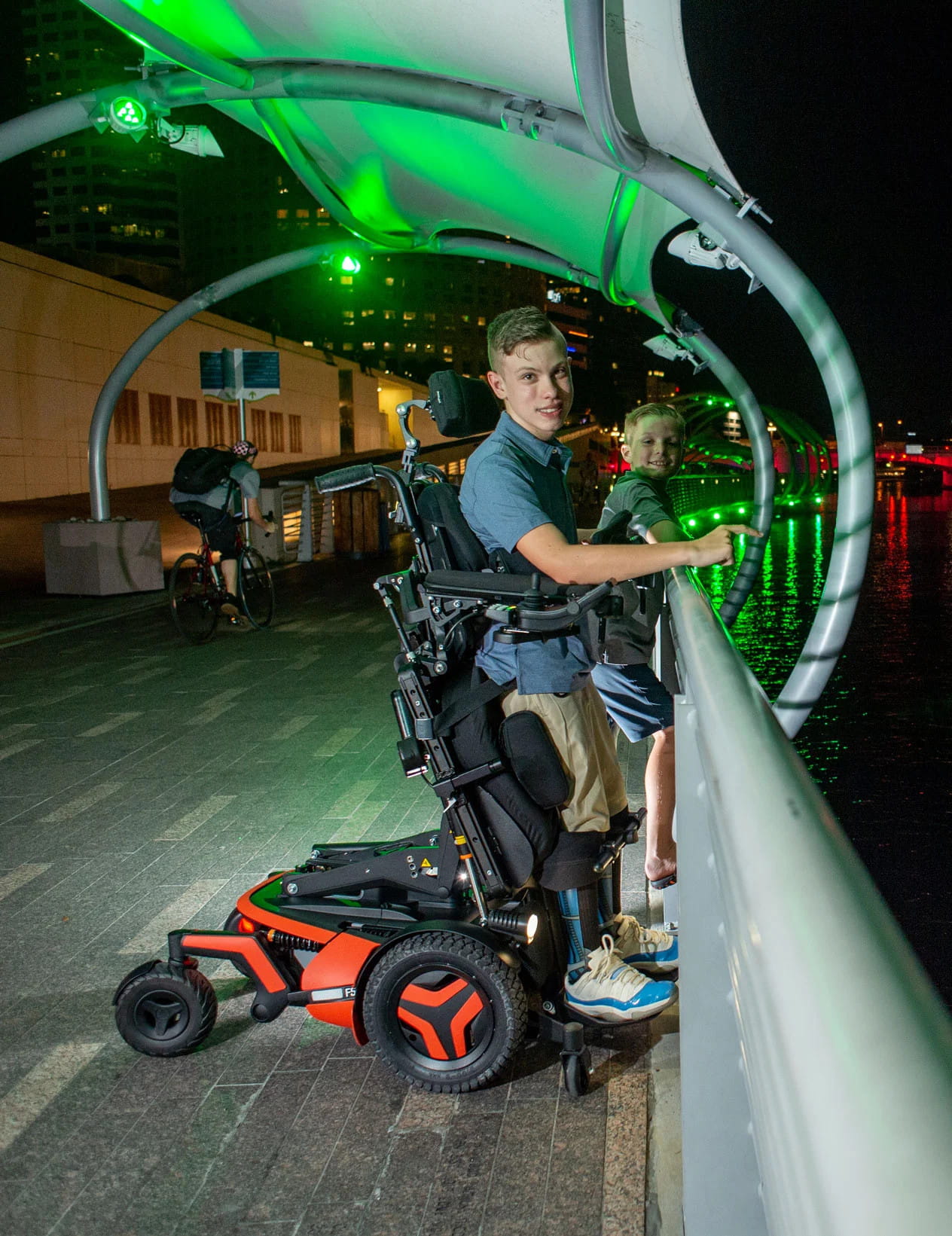
I think this was very important because it has increased my independence and my self esteem.Landon
Permobil has been making power standing wheelchairs for over 43 years. The F5 Corpus VS incorporates all of the essential features you need to be able to stand with confidence. Click on the dots below to learn more:
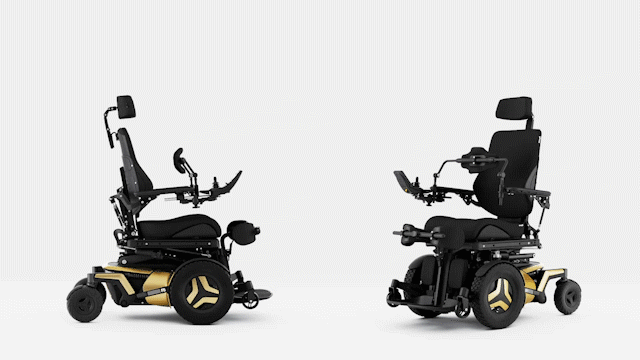
End users need a full range of power seat functions: We all know that standing provides many medical benefits and independence, but you may also need full power seat functions with your wheelchair. The ability to tilt, recline, elevate your leg rests, and elevate your seat can help you live your best life.
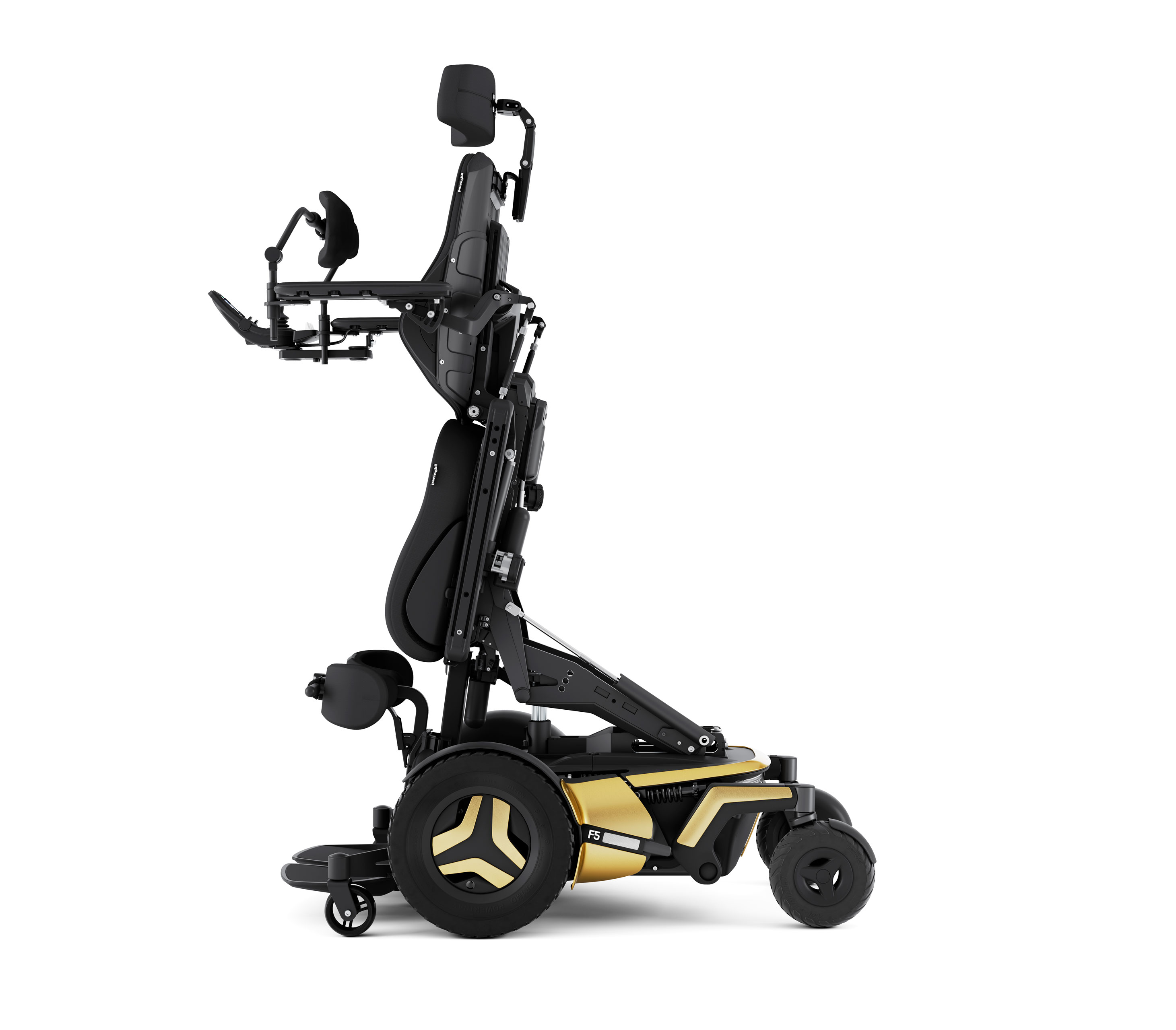

Stand sequences tailored to you: Whether you prefer to sit-to-stand, supine-to-stand or anything in between, the F5 Corpus VS allows you and your clinician to customize the stand sequences and actuator angles that work best for your body. Independent actuators provide you with the ability to also change seat-to-back angle while standing, truly personalizing the stand sequence to meet your needs, your environment, and your lifestyle.


Ideal posture & function in all positions: Postural concerns and range of motion limitations are now a thing of the past! The F5 Corpus VS allows you to maintain posture and participate in functional activities when you are seated or standing.

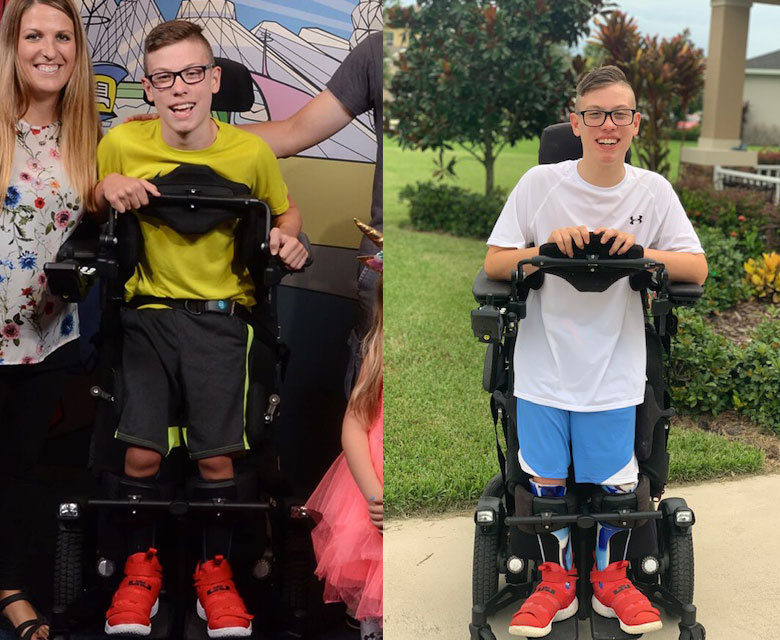
Ability to change as user’s needs change: Our chairs are designed to adapt to your postural needs throughout each day, as well as to changes in your diagnosis or condition over time. Updating your stand sequences, leg rest articulation, memory seating features, and seating angles can be made easily by your ATP or local rep.

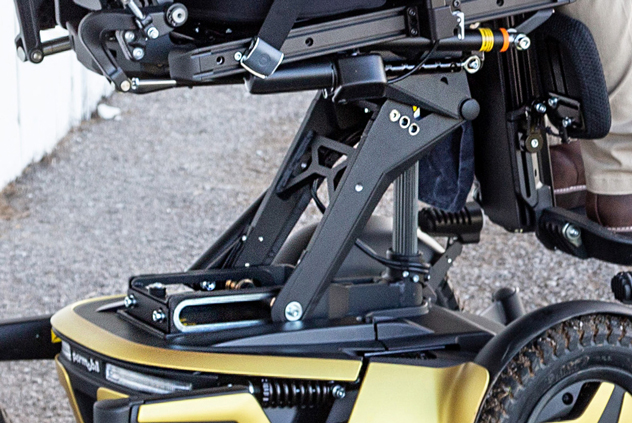
Seamless integration with the seating system and chassis: Permobil has been manufacturing standing power wheelchairs for decades, and you’ll see we have never been one for lots of cords, belts, or visible linkages. Things like this can get caught or bind up, making it difficult for the chair to operate fully and safely. Instead, we’ve created a seamless integration of the seating system on the chassis which provides you with greater stability in all positions.


Functional drive speeds with seat elevation and standing: Your access to the vertical world requires both standing and full seat elevation for maximum functionality. The F5 Corpus VS has empowered end users with 14” of power adjustable seat height, and a drive speed of 3.2mph while elevated. Advancements in our technology have also enabled us to provide a better, more reliable stand and drive system with support wheels that automatically deploy as you come to a standing position. This upgrade sets the F5 Corpus VS apart by providing increased stability while upright and driving.

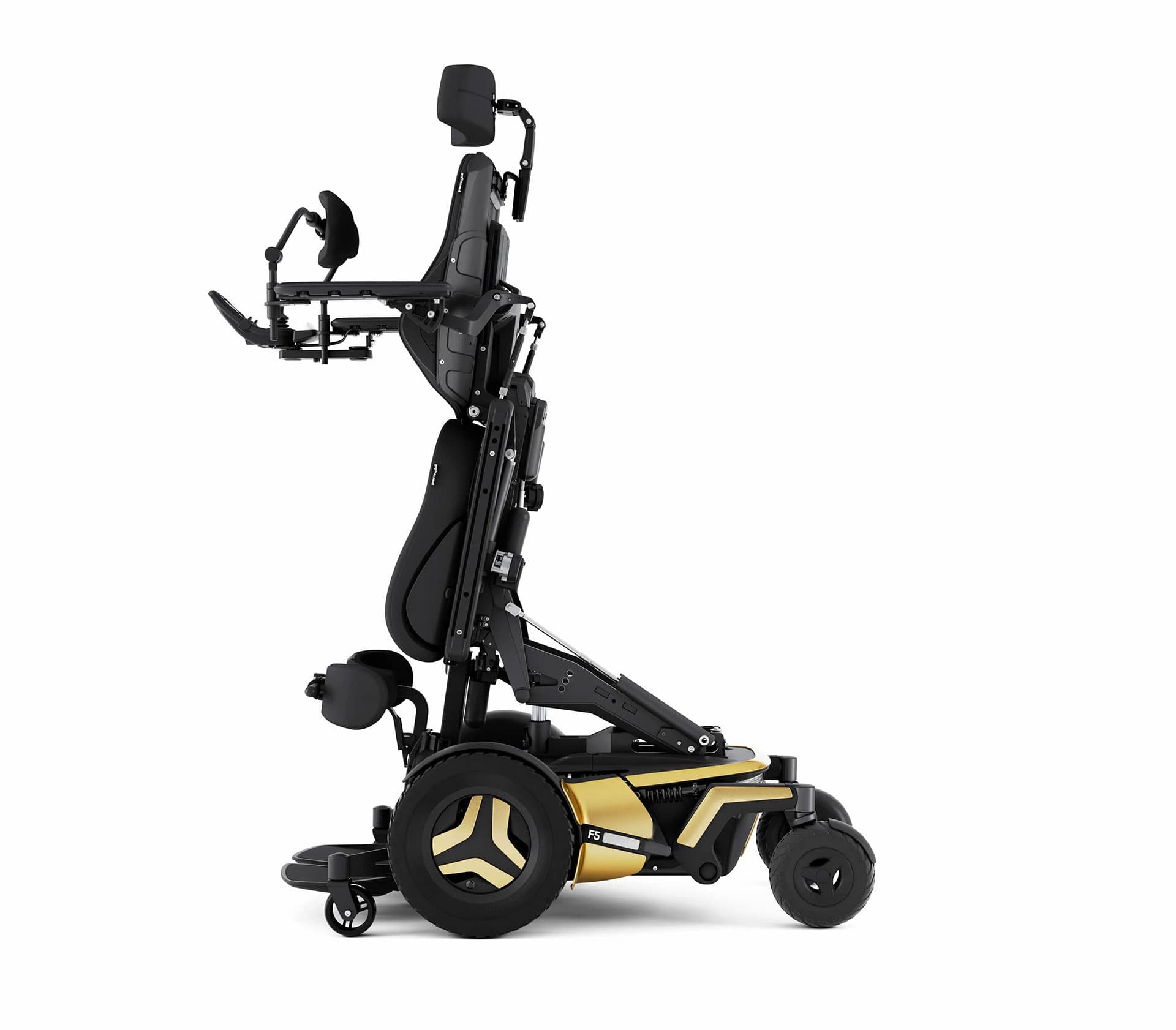
Just because you want to stand doesn’t mean you should have to give up power seat functions. If you currently use power seat functions such as tilt, recline, elevating leg rests, and seat elevation for medical and/or functional purposes, you should be able to have and use those on your standing power wheelchair. Be aware that some standing power wheelchairs have limited power seat functions which could compromise your daily routines.
We know that every individual is unique and has individual medical and postural needs. The sequence to standing should address these individual needs, whether it is sit-to-stand, supine-to-stand, or something in between. Consider a standing power wheelchair that can be programmed to address the personalized standing sequence and specific angles that work for your body. Not all standing power wheelchairs can accommodate unique needs, so don’t be afraid to ask for one that does.
For optimal function throughout the day you should not have to compromise your sitting position when you use the standing feature. In fact, the standing power wheelchair should be adjustable and programmed to provide you the best possible positioning in sitting and in standing, allowing you to perform daily tasks without skipping a beat. Losing your position in sitting shouldn’t be a fear when moving to a power standing wheelchair. Postural concerns and range of motion limitations should be able to be accommodated to enable you come to a standing position without having to compromise your seated position for day-to-day activities and driving.
“Change is a process not an event”. As the human body changes, the standing power wheelchair should adapt and change with you. Make sure that the wheelchair has extensive programming that can allow changes in stand sequence, memory seating features, and seating angles, to name a few. This will ensure optimal independence and function as your body/condition may change over time.
We know that a solid foundation is key to stability. This is especially true of standing power wheelchairs where the foundation is the chassis, and it is key for stability in standing. Some standing power wheelchairs have taken their existing chassis and simply added standing to it, which can result in instability. Be sure to ask about the chassis and whether it was built with standing in mind.
Your access to the vertical world requires both standing and full seat elevation. Reaching activities require the ability to adjust body position for environmental access and determining when an activity is best performed in a seated or standing position. Full seat elevation, with the ability to drive at a typical walking speed, is important for completing daily tasks. When driving in a standing position, it is important to have the ability to independently adjust your backrest angle for postural control and safely move from point A to B at a functional pace. If you’re considering a standing power wheelchair, make sure to ensure that the adjustability, stability and drive speeds in both seat elevation and standing will be functional for your daily life.
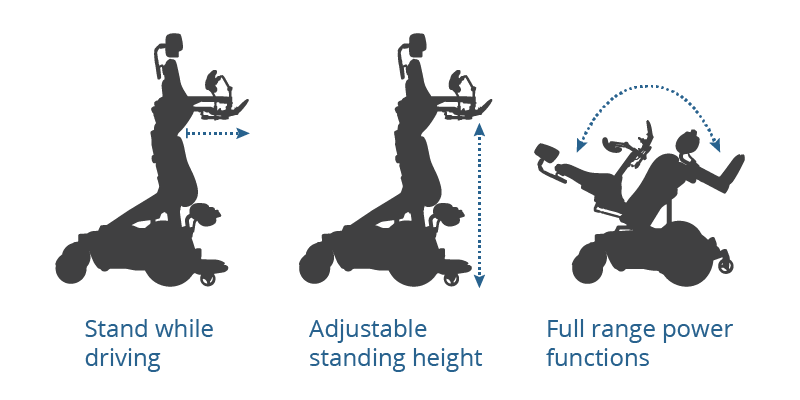
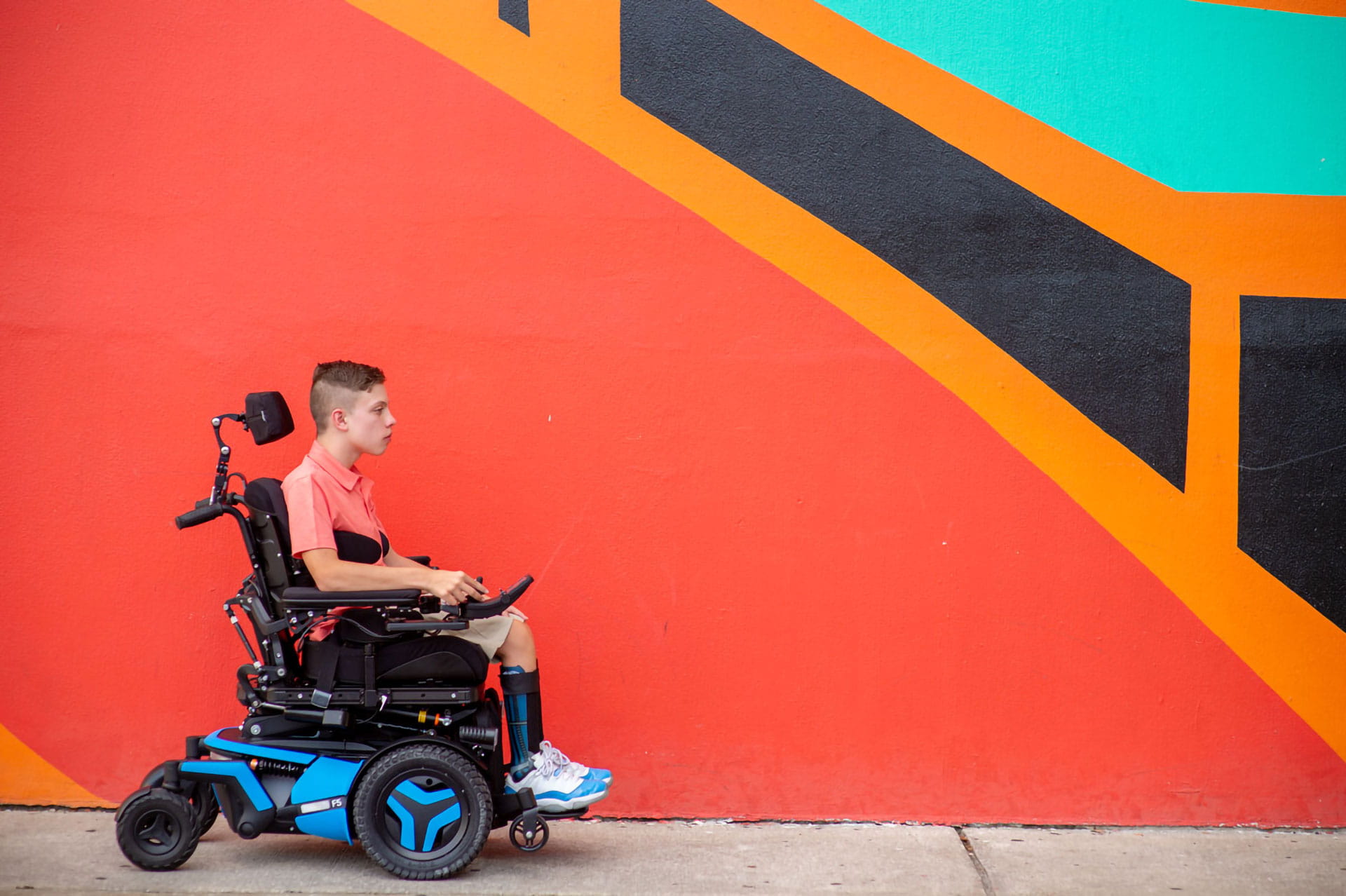
Birth: 2004 at 30 weeks with no other complications. Admitted for 5 weeks into the neonatal intensive care unit.
Diagnosis: Periventricular leukomalacia, Cerebral palsy
Chapter 1
Meet Landon, a 14 year old boy living with cerebral palsy who has experienced the functional and social benefits of being able to stand independently. Prior to getting his standing wheelchair, Landon used a walker to perform his standing protocol. He wasn’t able to perform standing daily as it was getting increasingly difficult for his parents to safely transfer and support him in his walker and he could only tolerate a few minutes before his legs would tremble.
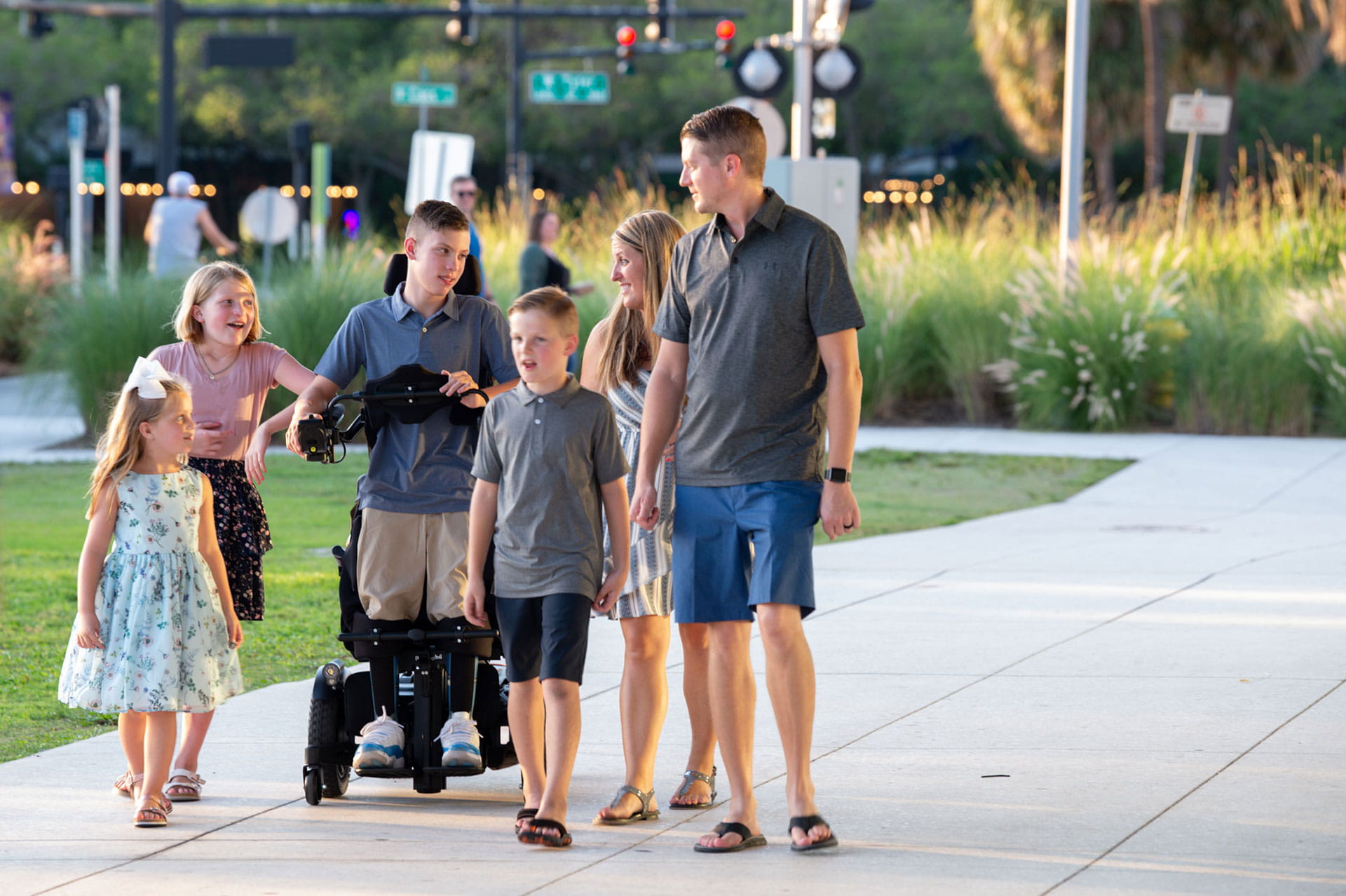
Landon is the oldest of six children. He and his siblings are home schooled, but they attend the local school for robotics and programming classes. They are part of a larger homeschool group and participate in various field trips throughout the school year. Landon is a typical teenager and in his spare time likes to go to the library, play video games, or hang out with his family or friends.
Chapter 1
The family is close knit and enjoys doing things together. They frequently go to Disneyworld on the weekends and Landon’s favorite rides are the rollercoasters. Landon’s brother plays baseball, and the all enjoy watching his games. Landon has recently gotten involved with a local theater group where he has the opportunity to act and sing. Last December they performed A Christmas Carol and he is currently rehearsing for the next musical, Beauty and the Beast. Landon will be the narrator in this show, and with his standing wheelchair he feels confident that he will be heard and understood.
Landon’s Permobil F5 Corpus VS has impacted his life in a number of ways. With his previous standard power wheelchair, he really struggled to keep up with his family and friends in daily activities. He had to rely on other people to help him with most things and it was a constant wait for him while adding responsibilities to those around him.
Today, when Landon is in his new wheelchair, he is much more independent and able to participate both physically and emotionally in a totally different way. The Permobil F5 Corpus VS has been life changing for both Landon and his family.

After years in a standard power wheelchair Landon began suffering from secondary conditions and without changing his seating system, these would only get worse as he got older. His parents took Landon to Shriners hospital where a therapist determined that he needed complex rehab technology.
Landon’s standard power wheelchair didn’t have power functions or individualized seating supports. This means he was unable to change positions independently throughout the day for various types of activities. His wheelchair was simply a device that could get him from point A to point B. He experienced daily pain in his back and buttocks and would sit hunched forward with his head down as this was his postural tendency and his wheelchair offered no support. This posture made it difficult to speak and be heard and also made it difficult for him to participate in many activities.
While he was still using his standard power wheelchair Landon was provided with a standing protocol by his therapist for frequent daily standing. He was performing his standing training with a walker since insurance wouldn’t pay for a manual stander and a wheelchair, so the family chose the wheelchair. Using the walker was very difficult for him because he was so unstable. He needed to have someone help him transfer to the walker and hold him in it because he would easily fall. For example, even the smallest unexpected sneeze would make him fall. Therefore, the frequency and duration of standing training sessions became less frequent and were certainly not as often as medically needed. The protocol recommended daily standing and the family was able to get him in his walker once or twice per week at best.
Due to his inability to walk or stand according to typical developmental milestones, Landon developed hip dysplasia and had surgery as a young boy to align his legs and hips. Prior to Landon receiving his Permobil F5 Corpus VS the orthopedic surgeon also instructed Landon to stand more frequently, daily, to prevent the need for another surgery. He also informed Landon that his osteoporosis was progressing, and that daily standing could help strengthen his bones. As Landon was growing older, taller and heavier it became even more difficult for his parents to safely get him into and support him in his walker for standing. With five younger children in the home who also needed attention, following medical best practice seemed unrealistic.
The parents were getting concerned about his medical and functional decline and turned to the Shriners hospital for help.

Chapter 2
After years in a wheelchair Landon suffered from secondary conditions and in combination with growing older he needed complex rehab tech.

Chapter 2
Landon and his parents booked an appointment at Shriners hospital. Based on the needs identified during his evaluation and standing trial the OT and ATP recommended that the team should submit for a Permobil F5 Corpus VS. He really needed to be performing a consistent standing program to be able to increase his bone density, align his lower extremities, and improve his posture and function.
The OT had recently submitted for a Permobil F5 Corpus VS for another child with similar needs that was approved by the same insurance company. The medical team expected a similar result since Landon presented with more serious medical needs than the other child did. So, they started this process with optimism.
When Landon and his parents first saw the Permobil F5 Corpus VS they were stunned. They had never seen anything like it, and they didn’t even know that the technology was available. They immediately realized how this wheelchair with all its functions could make a difference in all their lives, and how their daily lives could be different due to a product like this.
They were all determined that this was the wheelchair for Landon. So, the team submitted the documentation and the process began.
The process from identification of need to approval became a long struggle. The final successful outcome of this story is the result of an impressive team effort where everyone played an important role. The dedication and determination from people around Landon made this happen for him. It was a long process with two denials and a lot of hard work putting the documentation together before Landon finally got his wheelchair.
The team persisted through the denials because they truly believed that the Permobil F5 Corpus VS was needed for Landon’s health and independence. They believed that Landon had the right to the most appropriate equipment to optimize his health and independence so fighting for this wheelchair was the right thing to do. When the insurance company only approved the F5 with seat elevation, Permobil Foundation stepped in and completed the task of making sure Landon finally got the standing function which is what he needed to meet his medical and functional goals.
When we found out that there was an option for him to be able to actually stand that was huge and still feels like that. Very, very exciting to see how he has improved not only physically but overall, how to socialize and improving his self-confidence is huge.
Most times when a standing chair is pursued through insurance it is a challenge but because Landon was a perfect candidate and we had a strong team I was excited to begin the process
There was no going back and it was too late anyway. A lot of kids that get into their early teens often put on weight, where their motor skills don’t keep up or their strength and their endurance get less and less. So, with that age it is really more crucial to be independently mobile, or in his case individually stand due to osteopenia.
The letter included how Landon needed to get around his home and how he couldn't do things for himself because he was stuck in one position which was very limiting for his self-care
We knew Landon could be so much more functional in his home with that type of dynamic seating. He was stuck at one level all the time. And even with kids, even with just the seat elevator, ActiveHeight™, Landon is still two feet or 18 inches from a workable surface. It is great he can be high but tipping forward, using ActiveReach™, or being straight in standing to be closer to things. It makes a big difference.
Being able to be elevated and tilt forward, or stand is important because you have to use both hands to be functional. If you pull up sideways to a surface to get closer you can only use one hand to reach. So really being able to get close to what you work on, face on, makes being able to grab or lift things easier.
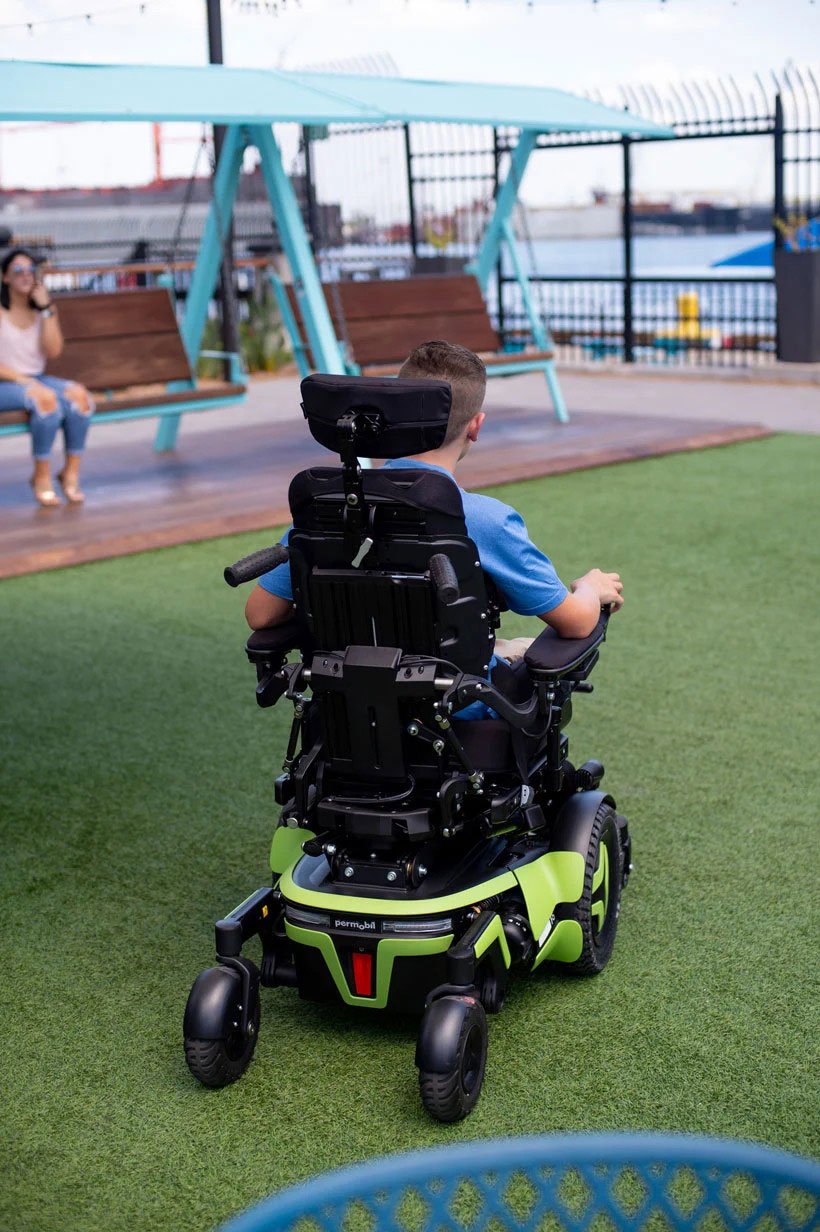

In the first denial the insurance company was very vague in its responses and the medical team had to spend hours on the phone to find and finally talk to a person who could answer the questions. A second submission was sent in with additional information like videos showing the benefits Landon had in his home while using a F5 Corpus VS.
After two rounds, the insurance company was bringing in a third party, a doctor, referring to a study regarding the need to be able to urinate independently. Based on that study they claimed that standing was not medically necessary but a luxury item. However, this study had nothing to do with Landon’s condition and all the needs he had. Instead the study was about adult men with able bodies. This just did not make sense for the medical team and it made them even more willing to keep on fighting.
At this point Landon was on bisphosphonate again, so the team had medical documentation that is was medically necessary for Landon to be in weight bearing positions to support the medical plan to improve his bone density and health. The therapist was able to include actual proof of how brittle his bones were, together with blood tests and dexo scans. Permobil supplied the team with some research studies and sites where the therapist supported her arguments with the documented proof.
According to the medical team, the family would probably have won this case if it had been denied a third time. However, this would have been a costly process as it would involve going to court and was not an option for the family.
Finally, the insurance company came back with an approval, but only for the seat elevator, ActiveHeight™, as a medical necessity. However, everyone interviewed in this project is convinced the only reason seat elevate was approved by the insurance company was to not have to pay for the more costly function of standing. They knew he needed a better wheelchair than he had and approving a seat elevator got them off the hook of paying for standing.
Well because it was a covered item* and it was the right thing to do.
Here is the thing, we feel like if we don’t fight for coverage the insurance companies win on regulating what they want to pay for. The more we fight the denial and make it difficult for the insurance companies under their guidelines, the more likely they are to approve the medically necessary options. They don’t want to spend all their time fighting with us, and we don’t want to spend all our time fighting against them.
When there is a covered item, it is a game of will. It is re-shaping one case at a time, and it is influencing the reviewer to be more reasonable. And I guess it is our job to when we feel that we put the medical information, the functional information all together is to know if it is covered or non-covered. If it is not covered we understand but if is a covered item then you are not working with us.
Insurance companies don’t want to tell you anything because they are going to block you from trying. It makes it harder to go down that path. When insurance companies make these determinations, like in the last denial when it was the third appeal, that one could have been taken to court. Had the family wanted to spend the money, their justification for the denial would be a yes.
I use the word cookie cutter, they put every kid into this and if the needs are above or beyond they fall outside the curve and it is easier for them to deny and hope that we will not fight for it.
*It was never determined it was not a covered item which means it is a covered item. It has to be medically necessary which they in the end denied.
Chapter 3
Standing in Permobil F5 Corpus VS is life changing. The best thing is that Landon does not have to wait for anyone else to help him stand, he just does it whenever and wherever he feels like it!
Chapter 3
Having options of moving into different positions helps for performing all daily tasks. Sometimes Landon uses the standing function and sometimes the seat elevation, ActiveHeight™, or seat elevation with forward tilt, ActiveReach™, it just depends on the situation and what he is wanting to accomplish. Landon has been using the standing function mainly for training but is increasingly using it for other things as he is getting stronger and getting used to the wheelchair and all its functions. In order to remember to stand for longer periods of time and more frequently he combines the training with watching TV.
He can now reach things at home that are higher up. He can go and get things for himself without having to ask for help. Landon sometimes drives in a standing position at home but not often in public as he is still working on his endurance. At home for example he will drive from watching TV to go and get a glass of water in standing.
At concerts and events Landon likes that he can stand to socialize and see over other people in a crowd. He also finds it easier to talk and articulate in standing, so he simply raises himself up when he wants to have conversations. Landon finds that the seat elevation, ActiveHeight™, is also really good for being seen in crowded places. For example, in crowds at Disneyworld he likes to drive in ActiveHeight™ since it puts him at an equal level with others, he can see over people, and be more engaged with all that is going on around him.
Being able to stand and sing is one thing that makes Landon especially excited about his new wheelchair. When he is standing, he is able to articulate better, and can even sing louder so that others can hear him. His mother shared her surprise and delight when she could actually hear Landon singing during a recent production he was in. In the past his, voice was much weaker and could not be easily heard.
When he sings you can actually hear him compared to when he is sitting down! It makes him more functional and truly a part of the group.
It’s just easier to talk now.
And it’s easier to do certain things like singing or talking if I’m standing upright. So I don’t have to sit like this, hunched over all the time.
My friends think it’s really cool.
Being able to reach things means independence and satisfaction as well as increased self-esteem―a young man managing life by himself. Reaching things on shelves or desks used to be a struggle. He couldn’t even get a glass of water by himself and had to always wait for someone to come and help. Today he just goes and gets himself a glass of water whenever he wants.

It makes me happy that I can do some stuff on my own now. The difference is less people are involved, less of a chance of getting hurt. It is safer and socially better, not to have to make a whole scene rather than just stand up.
I can stand independently, I don’t have to wait for people. Even if we did do like we normally did, it would be really hard to stand for this long. With this I can stand up whenever I want. Before I was not independent because I had to rely on other people for most things. It is important because I think you can get more things done when you can do it on your own rather than having to wait for other people to help you.
It’s now possible to get my own glass of water because I can stand up and reach the sink and not be so low to the ground like previously with other chairs.
As a parent it’s important for your kid to be as independent as possible because it’s important for self-esteem. You know it comes in so many different social aspects right now. Obviously we want him to be as independent as he can be, so eventually in the future when he is living on his own he will be able to do as much as possible on his own with as little assistance as possible.
Anything we can do to make his life better is always our goal. We wanted standing because we knew it would help with straightening out his legs and stop his need for infusions, because right now he has osteoporosis as a result of not standing.
Socialize, because it is easier to socialize when looking at somebody face to face rather than looking up at them. It just feels more natural when you are looking right at a person rather than looking up at them.
It is easier to get people’s attention if they can physically see you better. Just to know that people see me and know they can hear me makes me more confident compared to sitting down. They seem to acknowledge me more when they can see me and it feels more normal. When they are looking down and I am looking up at them it just seems kind of weird to say something.
I have noticed a difference when he is standing and socializing. I feel like people are acknowledging him differently when he is face-to-face with them. When he is sitting, it’s hard for him to make eye contact and socializing feels different.
Landon can now participate in environments that are not ideal for wheelchair users. At the museum Landon is able to stand at the kiosk and actually use it. Landon’s dad says that in today’s environment a lot of the stuff is for people who are standing, especially self-service portals. The screens of the kiosk are at an angle so if the person is not at that angle they can’t see.
After getting the Permobil F5 Corpus VS Landon could visit the arcade and for the first time enjoy the games which required him to be in a standing position.
Landon was able to look over a bridge when we were on vacation just like everybody else. Before the rails were always in the way so that he couldn’t see, or he had to look through the slats.
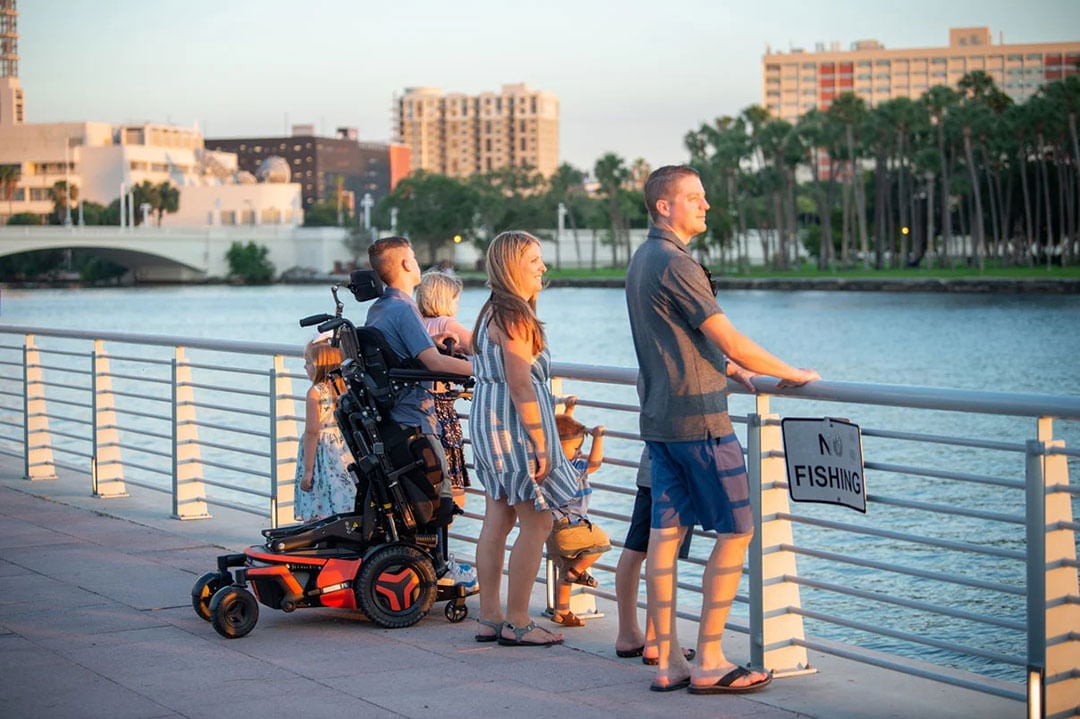
Chapter 4
Landon is becoming increasingly stronger after being able to stand more often and for longer periods of time

Chapter 4
After first receiving the Permobil F5 Corpus VS, Landon was so weak that it was very difficult to stand up for more than 10 minutes. The first time Landon stood up in the wheelchair his legs were shaking since he had not been in a standing position in so long.
It took some time for him to gain the muscle strength he needed in the muscles he had never really had to use before. Today his parents say that they can really see progress. He is becoming increasingly stronger and can stand for longer periods of time without his legs trembling.
Landon himself feels stronger and safer now because he can put more weight on his legs rather than through his arms and feels like he can support himself better.
A lumbar Z score compares your bone density to the average bone density of people the same age and gender. A score of -1.0 to -2.5 means you have low bone density or osteopenia and a score below -2.5 is diagnosed as osteoporosis. According to Landon’s Z-scores below, he had a score that indicated osteopenia in May 2017, and his score significantly improved with only a couple of months of a standing protocol using his standing wheelchair.
The therapist at Shriner’s presented the measurements of Landon’s Lumbar Z-score from before and after getting the standing wheelchair. In May 2017 he had started to show a worsening of his osteoporosis and on December 2nd, 2018 he was increasingly osteopenic. After only 12 weeks of being able to train in standing significant improvements were noted of his osteopenia.
He can stand for longer periods of time and more frequently because he doesn’t have to wait for me to have time help him. He doesn’t need help with any of that now. His hips are straighter, and he stands more solidly now, even when he does transfers.
I can tell just by looking at him that he looks different, his upper body is straighter. Even there he is not standing straight because he just got the chair, can’t you tell?
For the first days he had it, if he stood and worked for more than five minutes, you could see his legs tremoring.
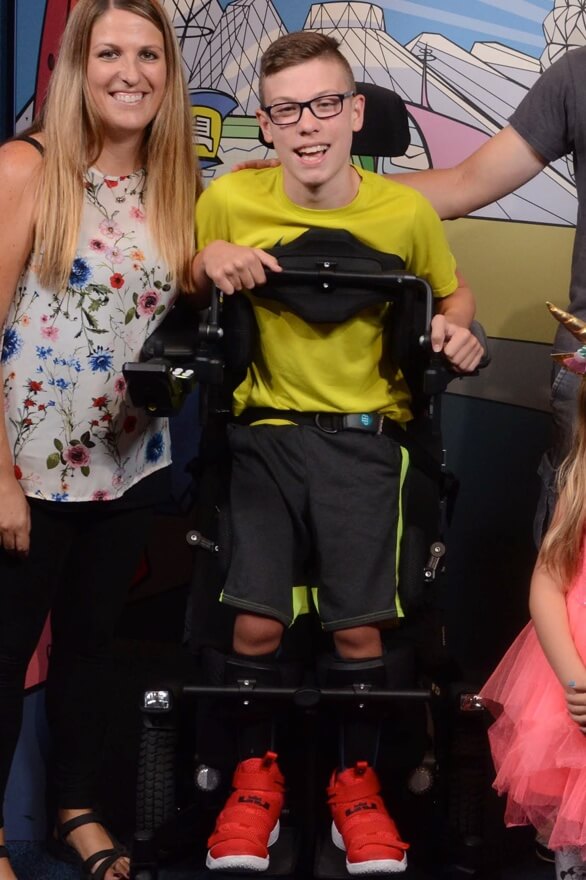
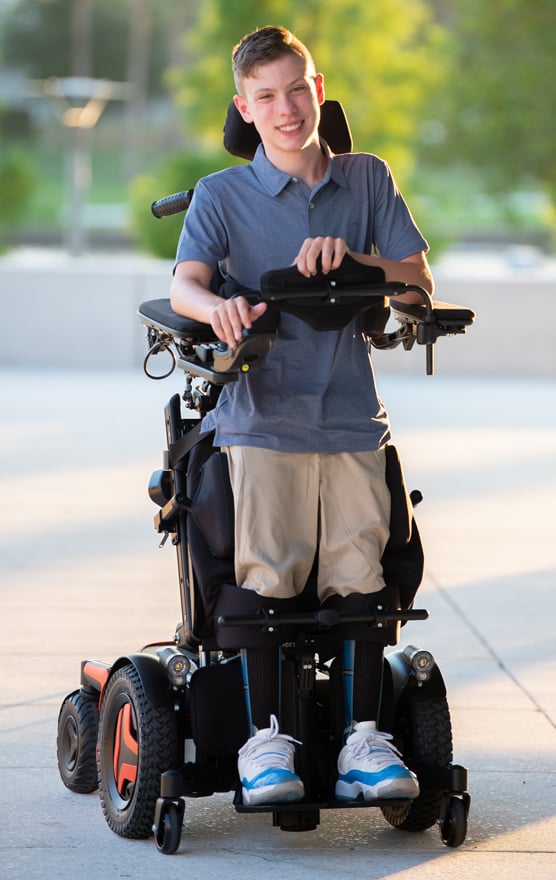
Social needs and medical benefits which are not proven by clinical documents are neglected in the funding process. However, the medical team and provider see the importance of the psychosocial benefits of providing the most appropriate equipment. Yet, the funding sources do not consider this in their determinations.
The guideline for funding they use to approve equipment are all based on medical needs. The don’t consider the social benefits or things like better breathing and digestion, things that we don’t have enough research on but that we know to be a probability using common sense. One thing we really need is real research that proves that over time it is going to save money to provide a standing wheelchair even if it costs more up front.
Look at his self-esteem. Here you have one very intelligent young man and his self-esteem is important as he is growing older and wanting to be more independent.
As Landon grows in confidence, he can develop more naturally and the mobility barrier of living away from home is all possible for him now. There are great consequences of getting a standing wheelchair, probably more than we know of.
Normal development, removing barrier for going off to college or do whatever he wants to do. It’s important for a young man to be able to stand and urinate rather than use a catheter. To be able to make his own decisions.
I hope he goes off to college and lives on his own. Or does whatever he wants to do and becomes a great taxpayer and takes care of me when I am an old person! I want him to live as independently as possible and give him the opportunity to move away and live outside his family home I think is huge.
You really helped us, the documentation Permobil provided was extensive.
There just does not seem to be enough research to support all these things that we as clinicians know can benefit these people. We need medical studies that can show the multiple benefits of a standing wheelchair. If there are perhaps some already out there, I don’t know about them.
Any specificity would improve the validity of what you are saying to the insurance company, to say “you cannot deny this, this has been supported in research." It is just that the quantity of research is just not out there yet. But Permobil helped with finding the existing research.
Chapter 5
The main reason for the recommendation of a F5 Corpus VS was the significant osteopenia. Landon needed to get into a consistent, daily standing program
Chapter 5
Alternative funding simply means the money is coming from somewhere other than your typical insurance coverage. In Landon’s case, he was able to get the extra funding he needed from the Permobil Foundation. But what are other options available?
There is always the option to pay cash out of your pocket for your standing system but for many this expense is out of their financial reach. The easiest option is to approach the typical funding source (insurance coverage) with the Group 3 power wheelchair (Permobil F3). Then proceed with the Permobil upgrade program using alternative funding. Essentially get the insurance to pay for the most expensive part and then find a way to cover the jump to a Group 4 standing wheelchair (Permobil F5 Corpus VS).

Some ways people find the funding include: GoFundMe, fundraisers (spaghetti dinners, raffles, etc), church, family members and some national organizations have a charitable arm that may be willing to help. For an extensive list of these organizations you can search the especialneeds.com/funding website for their contact information. Once these options have been exhausted you can request assistance from the Permobil Foundation as well.
If you feel a standing system will be beneficial to you or your client there are ways to secure funding, but you have to be willing to fight for it, like Landon’s family was. Permobil’s clinical and funding team is well versed on what it takes to get a standing system covered and we are always willing to help someone in need. We can be reached by email at US_Funding@permobil.com.
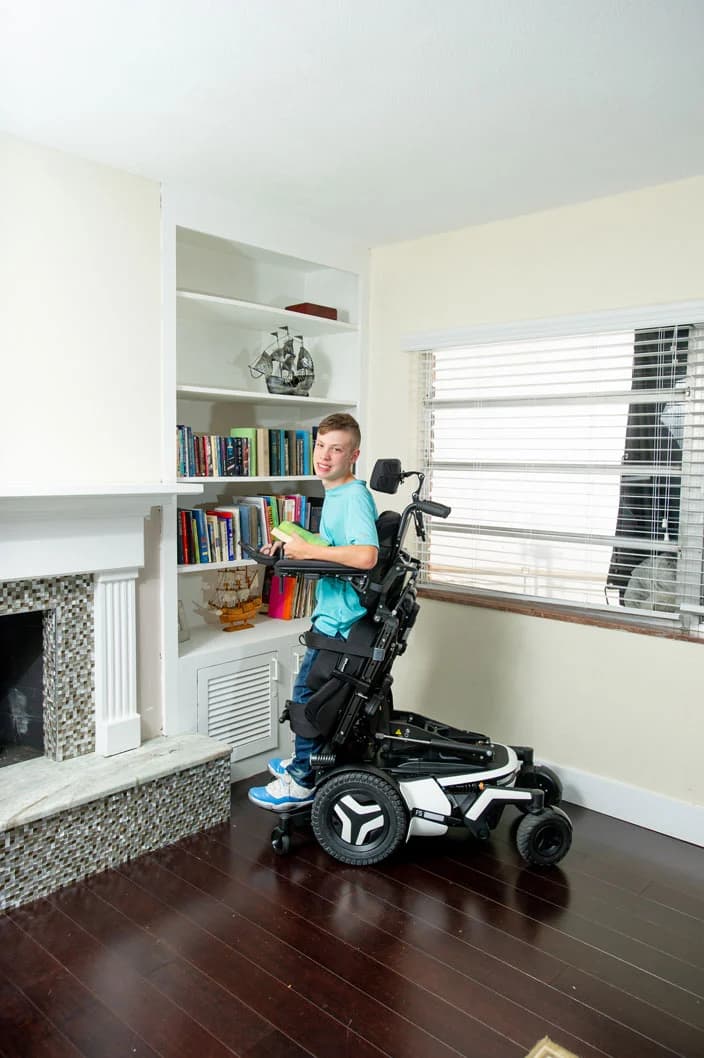


For more information contact a representative at 800-736-0925 or find a provider / retailer near you.
All contents © copyright 2019 Permobil. All rights reserved.
Interviews were arranged and coordinated by Katherine Petrocci, Territory Sales Manager, Permobil and Jennith Bernstein, Clinical Education Manager, Permobil. Interviews were conducted by Ann-Marie Engdahl, Director of Customer Insights, Permobil AB.
Interviewees include Landon and his parents, staff at the Shriners Hospital, representative from the provider, and a Permobil Sales Representative.
Dicianno, B., Morgan, A., Lieberman, J., & Rosen, L. (2013). RESNA POSITION ON THE APPLICATION OF WHEELCHAIR STANDING DEVICES: 2013 CURRENT STATE OF THE LITERATURE. Retrieved 25 July 2019, from https://www.resna.org/sites/default/files/legacy/resources/position-papers/RESNAStandingPositionPaper_Dec2013.pdf